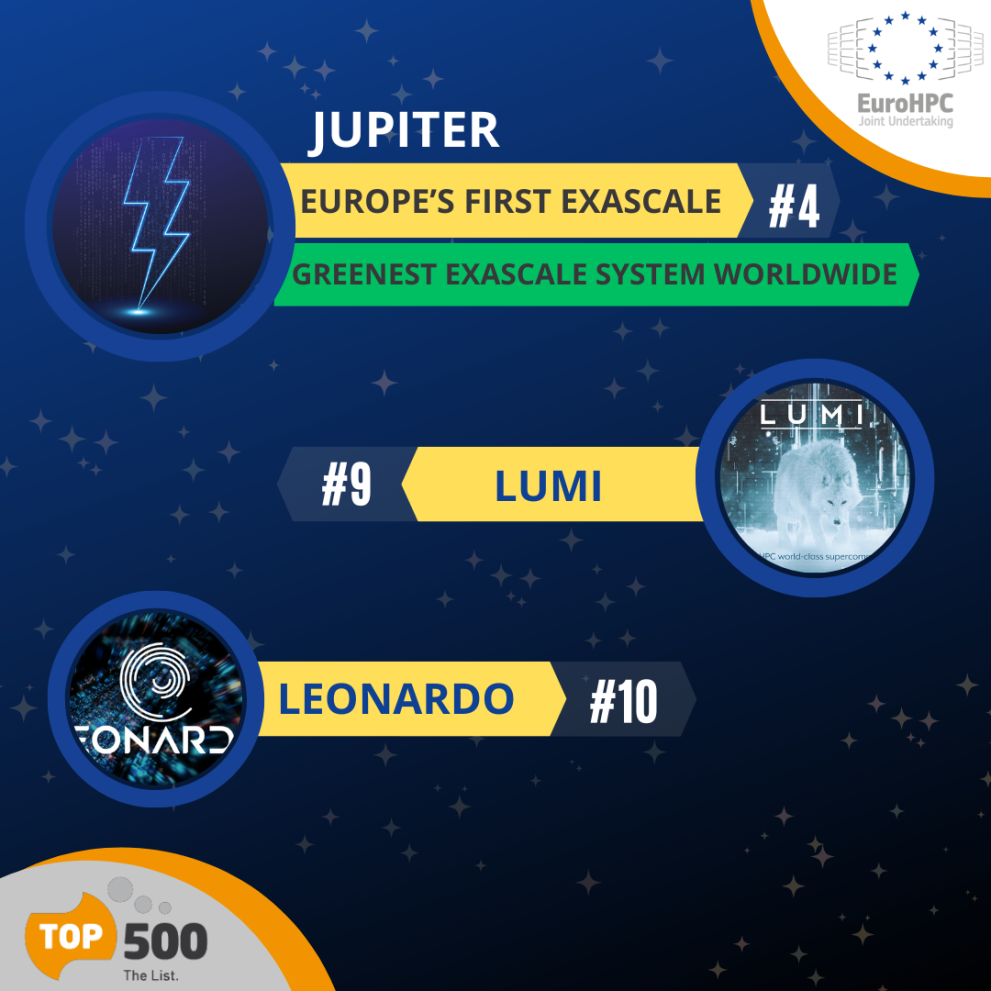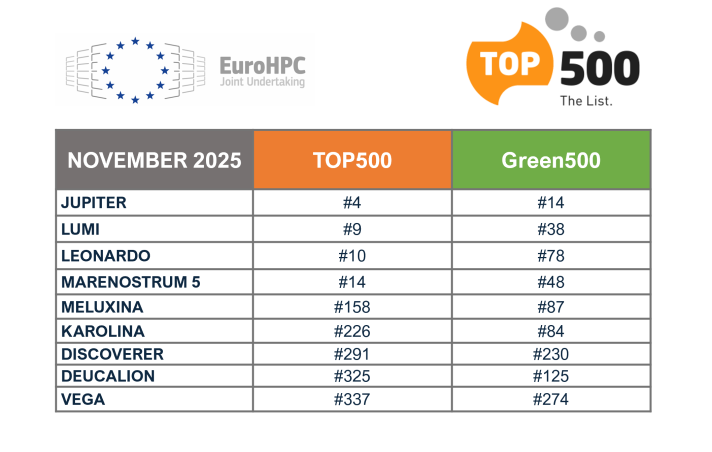
The latest editions of the TOP500 and Green500 lists were released today, Monday 17th November 2025, at the Supercomputing Conference SC being held this week in Saint-Louis, USA.
Once again, all operational EuroHPC supercomputers are featured on the TOP500 list of the world’s most powerful systems, enabling breakthrough research and innovation every day. Moreover, while JUPITER is the most energy-efficient exascale system worldwide, several EuroHPC systems also rank highly on the Green500 list, reflecting the EuroHPC JU strong focus on sustainable computing practices.
JUPITER Officially Launching Europe’s Exascale Era
JUPITER, hosted by the Jülich Supercomputing Centre (JSC) in Germany, has now reached its full exascale performance of 1 ExaFLOP, or more than 1 trillion (1,000,000,000,000,000,000) operations per second, officially ranking number 4 on the latest TOP500 list.
Inaugurated in September, JUPITER is Europe’s first exascale supercomputer, built on Eviden’s BullSequana XH3000 architecture and equipped with approximately 24,000 NVIDIA GH200 Grace Hopper Superchips. Its architecture delivers unprecedented capability for both large-scale simulations and advanced AI workloads. With its full exascale capability, JUPITER will now fully empower researchers across Europe to advance climate and energy modelling, materials science, biomedicine, and large-scale AI development, reinforcing Europe’s technological sovereignty and global leadership in supercomputing innovation.
With its highly energy-efficient BOOSTER partition, capable of more than 63 thousand millions operations per watt, JUPITER is also setting new standards in sustainability and stands out as the most energy-efficient exascale system worldwide. With its highly efficient warm water-cooling system, JUPITER is also designed to use the waste heat generated in operation to heat buildings and be integrated into the Jülich campus heating network.
JUPITER is also the cornerstone of the JUPITER AI Factory (JAIF), which is currently being developed as part of the EuroHPC JU’s initiative to establish AI Factories across Europe. Its goal is to help industry, particularly start-ups and small and medium-sized enterprises (SMEs), in harnessing JUPITER’s power to develop innovative AI applications.
EuroHPC Supercomputers: Leading in Performance and Sustainability
LUMI, operated by CSC in Finland with the LUMI consortium, ranks 9th and thus maintains its position in the global top 10 for the third consecutive year. Built on HPE Cray EX architecture, LUMI delivers 379.7 petaflops of computing power, continuing to accelerate European research and innovation.
Leonardo, operated by CINECA in Italy and based on Eviden’s BullSequana XH2000 technology, holds 10th place globally with 241,2 petaflops. The system remains among the world’s top 10 most powerful systems, a ranking it has maintained since November 2022.
EuroHPC's other operational systems, MareNostrum 5, Meluxina, Karolina, Discoverer, Deucalion, and Vega, all feature among the world's most powerful supercomputers. Most of them, including LUMI, Leonardo, MareNostrum 5, Meluxina, Discoverer, Vega, and Karolina, now also integrate AI Factories within their infrastructure. These AI Factories provide free tailored support for start-ups and SMEs, with additional AI-optimised computing resources to be added soon.
Another highlight of today’s TOP 500 publication is EuroHPC JU’s ongoing effort to procure green supercomputers, with many of its systems ranking highly on the Green500 list, a clear reflection of its strong focus on sustainable computing practices.
LUMI placed 38th with over 53 billion operations per watt. Powered entirely by carbon-free hydroelectric energy, LUMI employs liquid cooling technology and channels waste heat into the local district heating network. Its data centre leverages northern Finland's naturally cool climate for free cooling, maximising energy efficiency.
MareNostrum 5, operated by Barcelona Supercomputing Center and based on Eviden's BullSequana XH3000 technology, secured 48th place with over 48 billion operations per watt. Its advanced direct liquid cooling and energy-efficient design, combined with 100% green energy, demonstrate that sustainability and peak performance go hand in hand.
Background
The TOP500 list ranks the world’s 500 most powerful supercomputers according to their performance on the LINPACK Benchmark, while the Green500 list ranks them according to how many billions of operations a system can perform per watt of power consumed. Both lists are published twice a year and serve as essential benchmarks in the supercomputing community.
The EuroHPC JU is a legal and funding entity that brings together the European Union and participating countries to coordinate efforts and pool resources with the objective of making Europe a world leader in supercomputing.
To equip Europe with a cutting-edge supercomputing infrastructure, the EuroHPC JU has already procured 11 supercomputers, distributed across Europe. European scientists and users from the public sector and industry can benefit from EuroHPC supercomputers via the EuroHPC Access Calls no matter where in Europe they are located, to advance science and support the development of a wide range of applications with industrial, scientific and societal relevance for Europe.
Currently, the EuroHPC JU is also overseeing the implementation of 19 AI factories (AIF) across Europe that offer free, customised support to SMEs and startups. Six new AI Factories and thirteen AI Factory Antennas were selected last month, to complement the existing AIF network.
Additionally, the EuroHPC JU is deploying a European Quantum Computing infrastructure, integrating diverse European quantum computing technologies with existing supercomputers. EuroHPC JU already inaugurated PIAST-Q in Poznań, Poland, VLQ in Ostrava, Czechia as well as Ruby and Jade in Germany and France, marking a milestone in Europe’s leap into the quantum era.
The EuroHPC JU also funds research and innovation projects to develop a full European supercomputing supply chain, from processors and software to applications to be run on these supercomputers and know-how to develop strong European HPC expertise.
Details
- Publication date
- 17 November 2025
- Author
- European High-Performance Computing Joint Undertaking
